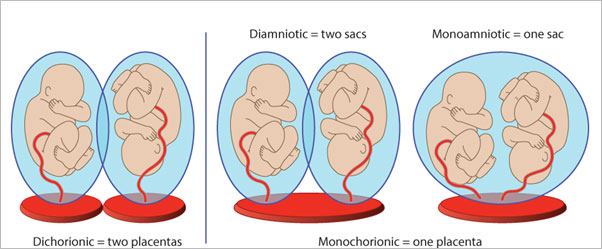A multiple pregnancy is one in which the mother carries more than one baby in her womb. Most commonly is it two called as twins. If there are three, it is called as triplet and if four, it is quadruplet pregnancy.
Fertilization of egg by a sperm is called zygote which later develops into embryo and then baby.
In non-identical twins (DIZYGOTIC), each egg is fertilized by different sperm. It is like two/ multiple babies with different genetic material growing in the womb at the same time.
This usually happens two or more eggs ovulate at the same time and get fertilized or two or more embryos were transferred in intro-fertilization process.
Identical twins (MONOZYGOTIC) develop from one egg and one sperm forming one zygote. Very early in the process, the fertilized egg or zygote splits into two or more embryos.
This is the concept of ZYGOSITY.
Monozygotic are the identical twins. They can be
Dizygotic will always be dichorionic and diamniotic- each baby has their own placenta and sacs.
This the concept of CHORIONICITY.

Chorionicity is to determine the type of placentation. Hence, we determine chorionicity and zygosity on the ultrasound.
Determination of chorionicity is important as it determines the type of complications the babies can have and the type of follow up they require.

The care has to be individualised for every multiple pregnancy. As these pregnancies are at risk of early delivery, weak babies, developing high blood pressure and sugars, hence the monitoring of babies by ultrasound needs to be individualised.
Also, the monochorionic pregnancies have unique set of complications like twin to twin transfusion syndrome (TTTS) where one baby bleedss into the other twin or selective fetal growth restriction, where one baby grows really small in comparison to the other baby. Hence, depending on how each multiple pregnancy behaves, we have to alter the protocol.
I can understand that these are somewhat difficult to understand but if you have any queries, I would be eager to answer all of them.